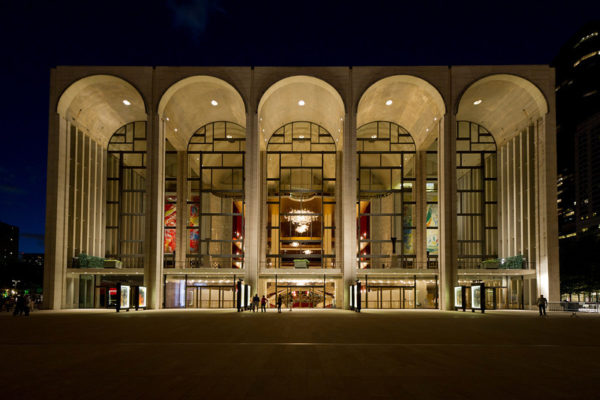Editor’s Note: This is the first in a series of articles looking at the unionized workforce producing some of the greatest theatrical productions in the world.
The world famous Metropolitan Opera employs about 2,400 unionized workers, represented by a range of unions, including the International Alliance of

Theatrical Stage Employees (IATSE), the American Guild of Musical Artists (AGMA), the American Federation of Musicians (AFM), the Directors Guild of America, the International Brotherhood of Teamsters (IBT), the International Union of Operating Engineers (IUOE), the International Union of Painters and Allied Trades (IUPAT), and the Service Employees Union (SEIU). The members are orchestral musicians, singers in the chorus, dancers, set painters, stagehands, carpenters, electricians, make-up artists, box office and call center employees, ticket takers, stage directors, costumers, among other professionals.
During its 135-year history, these laborers have made the Met’s productions possible, through their skilled work of bringing together the elements that result in an unforgettable experience. With a series of upcoming articles, LaborPress goes inside the Met to tell the story of these workers, and give insight into the professionals whose work is crucial to every successful production. This initial overview, the first in the series, is a look at the Met’s history, the Opera House itself, and fascinating backstage details.
Each season the Met stages more than 200 opera performances in New York. More than 750,000 people attend the performances in the opera house during the season, and millions more experience the Met through new media distribution initiatives and state-of-the-art technology. It was founded in 1883, with its first opera house built on Broadway and 39th Street by a group of wealthy businessmen who wanted their own theater. The Metropolitan Opera has always engaged many of the world’s most important artists, and many great conductors have helped shape the Met. The Met has also given the U.S. premieres of some of the most important operas in the repertory.
Onstage, night after night, creative and talented artists create theatrical magic. But there’s another universe behind the scenes – the hundreds of professionals who work virtually around the clock in service of the massive undertaking of making these productions possible. The Opera House auditorium has a capacity of 3,995, including standing room. It has outstanding acoustics: there are no 90-degree angles, and the shell-patterned decorations on the front of the boxes bounce the sound in all directions. African rosewood, cut from a single trunk nearly 100 feet long, was used for the wall paneling. Two different curtains are used at the Met. One is a “guillotine” made of red velour, which rises and descends vertically. The other is a “Wagner curtain,” a motorized tableau drape first conceived by Richard Wagner for his Festival Theater in Bayreuth. The Wagner curtain—the largest in the world—was installed in 1990 and is woven from 1,150 yards of Scalamandre silk. The sculpture above the proscenium was created by American artist Mary Callery.
The Met’s orchestra pit is designed for 100 musicians. If a small orchestra is called for, the front part of the pit can be replaced with a row of seats. A double-decked elevator at the rear of the pit can be raised to form an extended stage apron, and for concerts the entire surface can be raised to the stage level, eliminating the pit. The main stage, measuring 80 feet x101 feet, is divided into seven hydraulically operated elevators, making it possible to preset scenery to raise it to different levels. Fifty trap doors allow for entries and exits and the appearance of props and pieces of scenery from below. The rear and side working areas of the stage are equipped with wagons—platforms that can slide onto the main stage, bearing complete sets up to 30 feet high. The rear wagon also features a turntable, 57 feet in diameter, which can make a complete revolution in two minutes while rolling forward.
One hundred and ten feet above the stage—the equivalent of a ten-story building—the fly system is located. It consists of 109 pipes to “fly,” or hang, curtains, drops and scrims (a mesh-like material used to create transformation effects). On C level, three stories below ground, are two rehearsal rooms where elements or mock-ups of the stage sets are used.
The carpentry shop builds all scenic elements, from walls and staircases to trees and caves. Sets are designed to last 15 to 20 years, including assembling and disassembling before and after every performance or stage rehearsal. Upholstery is usually done in canvas or linen, then painted by the scenic shop to look like velvet or needlepoint. While there is a large scenic shop in the opera house, most sets are painted at a warehouse on 186th Street in Bronx, one of three the Met acquired in the 1980s. Brushes used for painting scenery range in size from very fine to nearly a foot in width. To facilitate painting on the floor, some brushes are mounted on poles so the artist may work upright. The scenic shop can make costumes look old or dirty by using special wire brushes, scrapers and sanders. The prop shop builds everything from furniture to swords to chandeliers. The makeup department prepares special pieces such as beards, bald caps, and scars. Putting on a principal artist’s makeup before a performance can take from 15 minutes to one hour. The wig shop makes and maintains most wigs worn on the Met stage. Each one is made from real human hair (or from Tibetan yak hair for white wigs!) and requires 35 hours of handwork. The costume shop creates most of the costumes for Met productions. When preparing a new production, a costume designer will usually give his or her sketches to the Met at least one year before construction begins, with the process often going from paper to pattern to muslin sample to finished fabric. Actual sewing takes from two days to two weeks per costume. Over the course of a season, the costume shop makes approximately 1,600 pieces of clothing.



